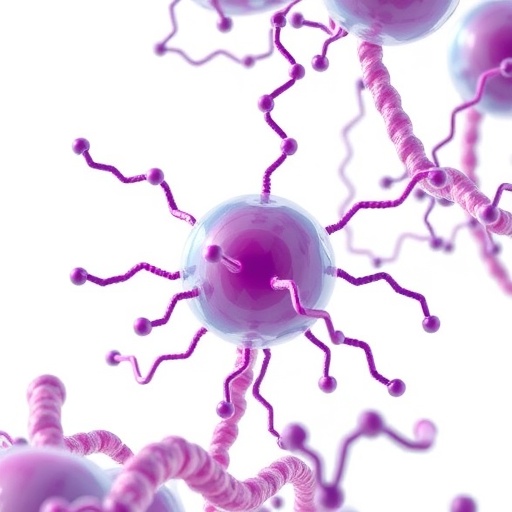In a groundbreaking study poised to reshape our understanding of cellular protein production, researchers at Janelia have unveiled a sophisticated interplay between two critical organelles inside eukaryotic cells—the endoplasmic reticulum (ER) and lysosomes. This newly discovered coordination mechanism not only challenges previous notions of intracellular translation dynamics but also highlights the nuanced role of organelle interactions in maintaining cellular homeostasis and responding to stress.
The endoplasmic reticulum is a sprawling network spanning the cytoplasm, distinguished by an elaborate architecture of tubules and sheets forming junctions critical for biosynthesis. Far from merely serving as a scaffold, the ER surface hosts ribosomes—complex molecular machines that translate messenger RNAs (mRNAs) encoding secretory and membrane proteins. These proteins constitute nearly a third of the human proteome and require the ER environment to ensure their proper translocation, folding, and insertion into membranes or secretion pathways.
Unlike cytoplasmic mRNAs, secretory and membrane protein mRNAs demand an extraordinarily precise orchestration during their translation, tightly coupled with translocation and folding processes. Any disturbance—such as stalled ribosomal elongation or misfolding—activates complex cellular stress responses almost instantaneously. These pathways recalibrate translation efficiency to mitigate damage, exemplifying the critical need for spatial and temporal control of protein synthesis within the ER.
Driven by these complexities, scientists have long speculated whether the ER’s architecture itself might facilitate such exacting regulation. Led by Heejun Choi of the Lippincott-Schwartz Laboratory, the Janelia team employed single-molecule imaging to directly visualize the translation of secretome mRNAs within living cells. Their findings shattered the assumption of homogenous translation across the ER surface. Instead, they observed discrete hotspots—specialized ER subdomains—where translation activity was concentrated.
These hotspots were characterized by the presence of Lunapark, a protein known to stabilize ER junctions where tubular segments intersect. This discovery indicates that Lunapark-dependent ER junctions serve not only as physical structural elements but also as critical nodes regulating where protein synthesis is locally orchestrated. Furthermore, these subdomains exhibited spatial proximity to lysosomes, organelles conventionally implicated in nutrient recycling and amino acid homeostasis.
The study revealed that when Lunapark was experimentally depleted, these translation hotspots disappeared. Ribosomes, instead of clustering, became dispersed, and the overall protein synthesis rate declined sharply. Of particular interest was the observation that treatment with ISRIB—an inhibitor that counteracts stress-induced translational arrest mediated via the eIF2 pathway—was capable of restoring translation. This suggests that Lunapark’s influence on translation operates via a stress-sensitive regulatory mechanism intricately linked to cellular stress signaling pathways.
Extending their investigation, the researchers delved into the role of lysosomes in modulating ER translation. During conditions of amino acid scarcity, they recorded an unexpected surge in translation activity proximal to lysosomes, implying that lysosomal signals might locally amplify protein synthesis. This phenomenon was abolished when lysosomal acidity was neutralized, confirming the organelle’s active regulatory role. This novel finding spotlights lysosomes as not just degradative compartments but integral players in directly tuning biosynthetic processes in neighboring cellular compartments.
Collectively, this research illuminates a finely tuned partnership between the ER and lysosomes, integrating nutrient sensing, metabolic signaling, and stress response with precise spatial control of secretome translation. Lunapark’s structural shaping of ER junctions and lysosomal metabolic cues form an interconnected system that choreographs the timing and location of protein production, ensuring cellular adaptability under varying physiological conditions.
This discovery challenges traditional paradigms that treated organelles as largely independent functional units, underscoring instead their dynamic crosstalk and interdependence in regulating fundamental biochemical processes. The implications extend into understanding diseases rooted in protein misfolding, ER stress, and lysosomal dysfunction, opening new avenues for therapeutic intervention by targeting spatially localized translation control.
Beyond its impact on cell biology, this revelation redefines our conceptual framework of how intracellular organization influences translational regulation. It evokes broader questions about how cellular architecture underpins molecular precision and coordination, fundamentally altering our perception of the intracellular environment as a highly organized and responsive landscape rather than a chaotic milieu.
In summary, this research from Janelia not only uncovers a previously hidden layer of complexity in cellular translation regulation but also asserts the importance of spatial compartmentalization and organelle interplay. The ER-lunapark-lysosome nexus now emerges as a central hub where protein synthesis, nutrient signaling, and stress responses converge, illustrating nature’s ingenuity in coupling structure with function at the molecular level.
As further work expands on these findings, we anticipate uncovering additional mechanisms by which cells leverage subcellular architecture to maintain proteostasis and respond dynamically to metabolic and environmental cues. This pioneering study sets the stage for future explorations into the geometry of cellular life and its profound influence on molecular physiology.
Subject of Research:
Coordination of secretory and membrane protein translation by ER subdomains marked by Lunapark and regulatory influence of lysosomes.
Article Title:
Secretome translation shaped by lysosomes and lunapark-marked ER junctions
News Publication Date:
5-Nov-2025
Web References:
10.1038/s41586-025-09718-0
Keywords:
Cell biology, Molecular biology, Endoplasmic reticulum, Lysosomes, Protein synthesis




